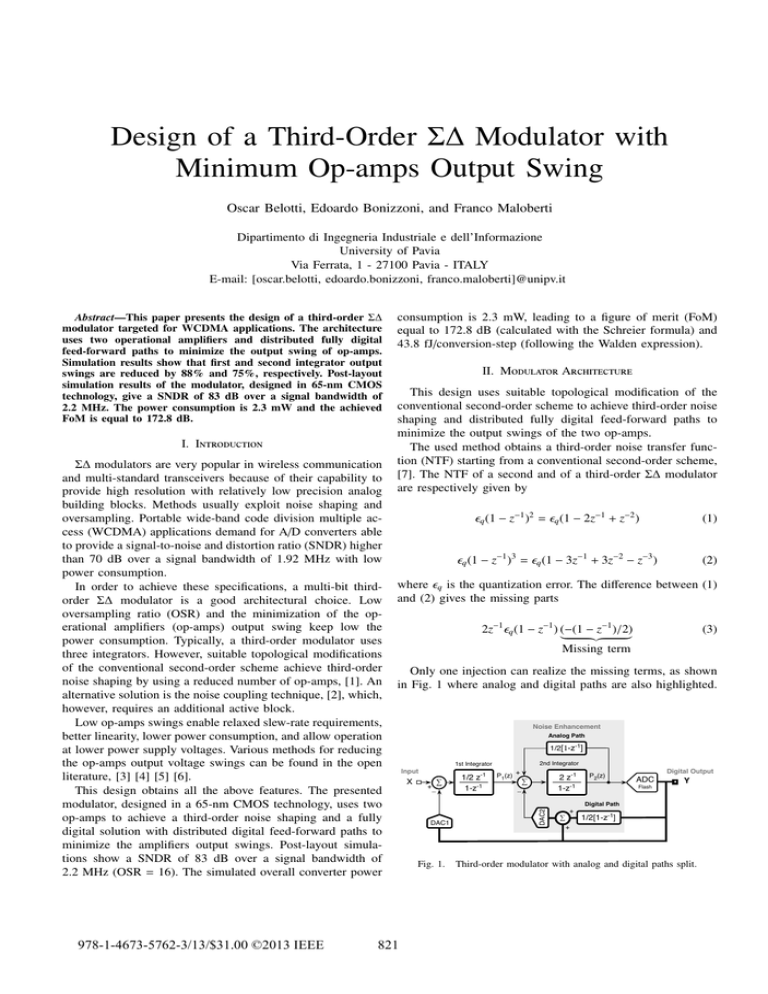Design of a Third-Order Sigma-Delta Modulator with Minimum
advertisement

Design of a Third-Order Σ∆ Modulator with
Minimum Op-amps Output Swing
Oscar Belotti, Edoardo Bonizzoni, and Franco Maloberti
Dipartimento di Ingegneria Industriale e dell’Informazione
University of Pavia
Via Ferrata, 1 - 27100 Pavia - ITALY
E-mail: [oscar.belotti, edoardo.bonizzoni, franco.maloberti]@unipv.it
I. Introduction
Σ∆ modulators are very popular in wireless communication
and multi-standard transceivers because of their capability to
provide high resolution with relatively low precision analog
building blocks. Methods usually exploit noise shaping and
oversampling. Portable wide-band code division multiple access (WCDMA) applications demand for A/D converters able
to provide a signal-to-noise and distortion ratio (SNDR) higher
than 70 dB over a signal bandwidth of 1.92 MHz with low
power consumption.
In order to achieve these specifications, a multi-bit thirdorder Σ∆ modulator is a good architectural choice. Low
oversampling ratio (OSR) and the minimization of the operational amplifiers (op-amps) output swing keep low the
power consumption. Typically, a third-order modulator uses
three integrators. However, suitable topological modifications
of the conventional second-order scheme achieve third-order
noise shaping by using a reduced number of op-amps, [1]. An
alternative solution is the noise coupling technique, [2], which,
however, requires an additional active block.
Low op-amps swings enable relaxed slew-rate requirements,
better linearity, lower power consumption, and allow operation
at lower power supply voltages. Various methods for reducing
the op-amps output voltage swings can be found in the open
literature, [3] [4] [5] [6].
This design obtains all the above features. The presented
modulator, designed in a 65-nm CMOS technology, uses two
op-amps to achieve a third-order noise shaping and a fully
digital solution with distributed digital feed-forward paths to
minimize the amplifiers output swings. Post-layout simulations show a SNDR of 83 dB over a signal bandwidth of
2.2 MHz (OSR = 16). The simulated overall converter power
978-1-4673-5762-3/13/$31.00 ©2013 IEEE
consumption is 2.3 mW, leading to a figure of merit (FoM)
equal to 172.8 dB (calculated with the Schreier formula) and
43.8 fJ/conversion-step (following the Walden expression).
II. Modulator Architecture
This design uses suitable topological modification of the
conventional second-order scheme to achieve third-order noise
shaping and distributed fully digital feed-forward paths to
minimize the output swings of the two op-amps.
The used method obtains a third-order noise transfer function (NTF) starting from a conventional second-order scheme,
[7]. The NTF of a second and of a third-order Σ∆ modulator
are respectively given by
q (1 − z−1 )2 = q (1 − 2z−1 + z−2 )
(1)
q (1 − z−1 )3 = q (1 − 3z−1 + 3z−2 − z−3 )
(2)
where q is the quantization error. The difference between (1)
and (2) gives the missing parts
2z−1 q (1 − z−1 ) (−(1 − z−1 )/2)
|
{z
}
Missing term
(3)
Only one injection can realize the missing terms, as shown
in Fig. 1 where analog and digital paths are also highlighted.
821
Noise Enhancement
Analog Path
1/2[1-z-1]
2nd Integrator
1st Integrator
Input
X
+_
∑
1/2 z-1
1-z-1
P1(z)
+
2 z-1
1-z-1
∑
_
P2(z)
Digital Output
ADC
Flash
Y
Digital Path
DAC1
Fig. 1.
DAC2
Abstract—This paper presents the design of a third-order Σ∆
modulator targeted for WCDMA applications. The architecture
uses two operational amplifiers and distributed fully digital
feed-forward paths to minimize the output swing of op-amps.
Simulation results show that first and second integrator output
swings are reduced by 88% and 75%, respectively. Post-layout
simulation results of the modulator, designed in 65-nm CMOS
technology, give a SNDR of 83 dB over a signal bandwidth of
2.2 MHz. The power consumption is 2.3 mW and the achieved
FoM is equal to 172.8 dB.
∑
+
1/2[1-z-1]
+
Third-order modulator with analog and digital paths split.
Auxiliary
Quantizer
Auxiliary
Quantizer
εq1
εq2
Quantized Input
Flash
X
Digital Feedforward
H2
[1-z-2]
H1
H4
1/2z-1[1+z-1]
1/2z-1[1-z-1]2
Flash
DAC4
DAC5
1st Integrator
_
Input
X
+_
∑
1/2 z-1
1-z-1
Main
Quantizer
1/2[1-z-1]
P1(z)
_
+
+_
∑
+
+
2 z-1
1-z-1
∑
∑
_
P2(z)
DAC1
DAC2
DAC
Digital Path
ADC
Flash
Digital Feedforward
H1+H4
[1-z-2]
1/2z-2[3-z-1]
DAC3
DAC4/5
Noise Enhancement
+
+
H3
Analog Path
[z-2]
εq
2nd Integrator
X
H2
H3
Analog Path
DAC3
Quantized Input
ADC
Noise Enhancement
Digital
Output
∑
_
Input
X
Digital
Summa
+_
1/2 z-1
1-z-1
∑
P1(z)
+
+_
+
2 z-1
1-z-1
∑
∑
_
1/2[1-z-1]
P2(z)
ADC
Flash
DAC2
DAC1
+
+
∑
Digital
Output
Y
Digital
Summa
Digital Path
Digital Domain
[z-2]
εq
2nd Integrator
1st Integrator
Y
Main
Quantizer
1/2[1-z-1]
DAC
ADC
1/2[1-z-1]
Digital Domain
Fig. 2.
Third-order modulator with distributed feed-forward digital paths.
Fig. 3.
Final third-order modulator block diagram.
A. Op-amps output swing minimization
The reduction of the operational amplifiers output voltage
swing decreases the overall modulator power consumption.
Indeed, output swings minimization leads not only to relaxed
slew-rate requirements, but also it ensures better performance
in terms of harmonic distortion. In addition, minimum output
swing enables the use of power efficient and compact singlestage op-amps architectures (e.g., the telescopic cascode).
The method of this design, proposed in [5], grants the
minimum output voltage swing for both operational amplifiers
by means of distributed digital feed-forward paths without
modifying the modulator signal transfer function (STF) and
NTF. The cost of the method is an extra quantizer which
digitizes the input signal.
The output of the first integrator (Fig. 1) is given by
q
q
X −1
z (1+z−1 )− (1−z−1 )2 = X · H1 − (1−z−1 )2 (4)
2
2
2
where X is the input signal multiplied by the transfer function
H1 . The main contribution to the swing of this node is given
by the input; in order to compensate for its effect, it is
convenient to process its quantized version, indicated as X.
The quantization of the input signal X is equals to X+q1 ,
where q1 is the quantization noise of the extra quantizer. The
information does not change if the quantity H1 X is added and
subtracted at the output P1 (z). The term -H1 X is then shifted
in front of the first integrator by dividing it by the integrator
transfer function. The result is an additional injection at the
input of the first integrator equal to H2 X, where H2 is (1−z−2 ).
This way, the output P1 (z) is given by:
P1 (z) =
P2 (z) = Xz−2 −q z−1 (3−z−1 )(1−z−1 ) = X·H3 −q z−1 (3−4z−1 +z−2 )
(6)
Addition and subtraction of X multiplied by the same
transfer function of the main contribution of P2 (z) obtain the
reduction of the swing of the second integrator. The quantized
input X is then multiplied by H3 and shifted in front of the
second integrator. The transfer function H3 referred to the
input of second integrator becomes H4 = 1/2z−1 (1 − z−1 )2 . The
reconstruction of P2 (z) due to the term +H3 X can be shifted
in digital domain after the main quantizer.
The overall third-order modulator with distributed feedforward digital paths is shown in Fig. 2. Combination of digital
functions and suitable topological modifications lead to the
scheme used in this design illustrated in Fig. 3.
III. Behavioral Level Simulation Results
The best trade-off between swings reduction effectiveness,
power consumption, resolution and complexity suggests to use
a 5-bit and a 4-bit flash converter in the main quantizer and
for the auxiliary quantizer, respectively. The effectiveness of
the used swing reduction technique is proved with MatlabSimulinkT M behavioral simulations. The effectiveness of the
Signal Bandwidth = 2.2 MHz | Fin = 2.18 MHz @ -2 dBFS
OSR = 16 @ FS = 70.4 MHz | VREF = 1.2 V
0.55
0.44
0.33
Amplitude (V)
1
P1 (z) = z−1 [q (1 − z−1 )2 + q1 (1 + z−1 )]
(5)
2
The output is now dominated by the quantization error q
shaped at the second order and by the auxiliary quantization
error q1 multiplied by (1 + z−1 ). The use of multi-bit solution
ensures low level swing.
The procedure can be repeated also for the second integrator, which is closed in feedback loop with the analog path
1/2(1 − z−1 ). The structure has a transfer function equal to
2z−1 /(1−z−1 )2 . The output P2 of the second integrator of Fig. 1
can be expressed as:
0.22
Output First Int. without DAA
0.11
0
Output First Int. with DAA
−0.11
−0.22
−0.33
−0.44
−0.55
0
500
1000
1500
2000
2500
3000
3500
4000
Sample
Fig. 4. Output swing of the first integrator with and without reduction
technique.
822
Signal Bandwidth = 2.2 MHz | Fin = 2.18 MHz @ -2 dBFS
OSR = 16 @ FS = 70.4 MHz | VREF = 1.2 V
0.3
0.25
VSS
0.2
Amplitude (V)
0.15
Output Second Int. without DAA
VDD
Vin
0.1
0.05
0
Output Second Int. with DAA
VDD
−0.05
Vout
VSS
Low VTH
HIGH VTH
−0.1
−0.15
−0.2
−0.25
−0.3
Fig. 7.
0
500
1000
1500
2000
2500
3000
3500
Full swing composite switch.
4000
Sample
Fig. 5. Output swing of the second integrator with and without reduction
technique.
technique is tested by applying an input sine wave at 2.18 MHz
(close to the signal bandwidth limit = 2.2 MHz) with an
amplitude of -2 dBFS . The oversampling ratio is 16 and
consequently the sampling frequency is 70.4 MHz.
Fig. 4 shows the output voltage swing for the first integrator
with and without swing reduction technique. The output swing
goes down from ±0.504 V to ±0.065 V, which corresponds
to a swing reduction of 88%. For the second integrator, the
benefit is approximately 75%, from ±0.28 V to ±0.076 V, as
shown in Fig. 5. As an additional benefit, thanks to this swing
reduction at the output of the second integrator, the number of
comparators used in the main quantizer can be reduced from
31 to only 9 still granting the 5-bit quantization, thus saving
area and power.
VDD
M37
VDD
M35
VDD
+_ _
+
M36
OP-AMP1
VOUTN
M33
M34
OP-AMP2
_ +
+_
VSS
VINP
M38
VCMFB1
M31
VSS
Vbias1
VSS
VDD
VDD
IV. Circuit Implementation
The fully differential switched-capacitors implementation of
the modulator has been realized in a 65-nm CMOS technology.
As mentioned, low output swing allows using single-stage
op-amp scheme. This design uses the conventional telescopic
scheme with gain boosting shown in Fig. 6. The auxiliary
amplifiers (OP-AMP1 and OP-AMP2) are conventional folded
cascode schemes with p-channel and n-channel input stage,
respectively. The supply voltage is 1.2 V. Different bias
currents (250 µA for first op-amp and 280 µA for the second)
allow achieving the slightly different gain and bandwidth
requirements. The first op-amp has a 94-dB DC gain and 240MHz GBW while the second obtains 90-dB gain and 270-MHz
bandwidth.
To limit the sub-threshold off current leakage of analog
switches that can cause analog performance degradation, this
design uses the composite switch scheme given in Fig. 7.
The scheme requires the use of transistors with low and high
threshold voltage. Two high VT H complementary transistor are
used in parallel with a series transmission gate. The high gate
ensures good conduction when the input signal, Vin , is close to
the rails, while at middle rail series transmission gate conducts
well, [8].
The voltage comparator used in the two flash ADCs consists
of a preamplifier followed by a regenerative latch. The nonconventional fully differential preamplifier is shown in Fig. 8.
Vn and V p are connected to the input of the latch (not
VOUTP
VDD
VSS
M32
M7
VSS
VINN
M10
Vn
M30
VSS
VSS
M8
VDD
Va
VDD
M9
M12
Vinp
Vb
M3
M4
VSS VSS
M1
VSS
Vrefp Vrefn
M5
VSS VSS
M2
VSS
M6
Vinn
Vb
VSS
Vp
M11
VSS
VSS
Fig. 6.
Gain boosted telescopic operational amplifier.
Fig. 8.
823
Schematic diagram of the comparator preamplification stage.
Matrix Array (32*32)
Implementation
Example A + B = Y 10 + (-1) = 9
From
Auxiliary Quantizer
B
15
14
0
1
CLK1
IN1
-2
-3
IN3
IN1
IN3
IN1
IN3
-15
-16
IN1
IN3
OUT1
OUT2
OUT1
OUT2
OUT1
OUT2
OUT1
OUT2
12
3
CLK1
IN2
IN1
IN1
IN3
IN2
IN1
IN1
IN3
IN2
IN1
IN1
IN3
IN2
IN1
IN1
IN3
OUT1
OUT2
OUT1
OUT2
OUT1
OUT2
OUT1
OUT2
11
10
4
CLK2
5
CLK1
IN2
IN1
IN1
IN3
IN2
IN1
IN1
IN3
IN2
IN1
IN1
IN3
IN2
IN1
IN1 CLK2
IN3
9
OUT1
OUT2
OUT1
OUT2
OUT1
OUT2
OUT1
OUT2
8
6
CLK2
7
CLK1
IN2
IN1
IN1
IN3
IN2
IN1
IN1
IN3
IN2
IN1
IN1
IN3
IN2
IN1
IN1
IN3
OUT1
OUT2
OUT1
OUT2
OUT1
OUT2
OUT1
OUT2
1
0
14
IN2
IN1
IN1
IN3
IN2
IN1
IN1
IN3
IN2
IN1
IN1
IN3
IN2
IN1
IN1
IN3
-15
15
CLK1
CLK2
OUT1
OUT2
OUT1
OUT2
OUT1
OUT2
OUT1
OUT2
GND
CLK2
IN2
IN1
IN1
IN3
IN2
IN1
IN1
IN3
IN2
IN1
IN1
IN3
IN2
IN1
IN1
IN3
CLK1
-16
IN2
A
GND
CLK1
OUT1
OUT2
OUT1
OUT2
OUT1
OUT2
OUT1
OUT2
CLK2
IN2
IN1
IN2
IN1
IN2
IN1
IN2
IN1
15 Y
14
13
12
Output Modulator
-1
13
2
CLK2
reduced by 88% and 75%, respectively. This swing reduction
allows using power efficient telescopic schemes for both
amplifiers. Post-layout simulations confirm the effectiveness
of the approach.
From
Main Quantizer
References
11
10
9
8
CLK2
IN1
OUT1
IN3
OUT2
GND
GND
IN1
IN3 CLK1
OUT1
OUT2
IN2
IN1
IN1 CLK2
IN3 CLK1
OUT1
OUT2
Fig. 9.
IN2
IN1
IN1 CLK2
IN3 CLK1
OUT1
OUT2
IN2
IN1
IN1 CLK2
IN3 CLK1
OUT1
OUT2
IN2
IN1
IN1 CLK2
IN3 CLK1
OUT1
OUT2
IN2
IN1
IN1 CLK2
IN3 CLK1
OUT1
OUT2
IN2
-15
IN1 CLK2
-16
Implementation of the switches matrix.
shown) by means of switches which are opened during the
regeneration phase in order to limit the kickback effect.
DAC, DAC1 and DAC2 of Fig. 3 are realized with a single
Kelvin divider with 32 levels. A single resistive string provides
the required 16 levels for DAC3 and DAC4/5. The sizes and
value of the unity resistance ensure the required accuracy
without the need of trimming or calibration and speed at a
reasonable cost of area and power consumption. In addition,
the use of the same resistive string to generate the differential
reference voltages cancels at the first order the error caused
by a gradient, [7].
A barrel shifted architecture based on a matrix of simple
switches (Fig. 9) realizes the digital addition of the output of
the main and auxiliary quantizer (see Fig. 3), saving digital
power at the cost of an affordable increased chip area.
[1] E. Bonizzoni, A. Pena Perez, F. Maloberti, and M.A. Garcia Andrade, “Two Op-amps Third-Order Sigma-Delta Modulator with 61 dB
SNDR, 6 MHz Bandwidth and 6 mW Power Consumption”, Proc. of
IEEE European Solid-State Circuits Conference (ESSCIRC), pp. 218221, Sept. 2008.
[2] K. Lee, M. R. Miller, and G. C. Temes, “An 8.1 mW, 82 dB DeltaSigma ADC With 1.9 MHz BW and -98 dB THD”, IEEE Journal of
Solid-State Circuits, pp. 2202-2211, Aug. 2009.
[3] K. Y. Nam, S.-M. Lee, D.K. Su, and B. A. Wooley, “A Low-Voltage
Low-Power Sigma-Delta Modulators for Broadband Analog-to-Digital
Conversion”, IEEE Journal of Solid-State Circuits, vol. 40, pp. 18551864, Sept. 2005.
[4] A. A. Hamoui, M.Sukhon, and F. Maloberti, “Digitally-Enhanced HighOrder Σ∆ Modulators”, Proc. of IEEE International Conference on
Electronics, Circuits, and Systems (ICECS), pp. 1115-1118, Aug. 2008.
[5] H. Caracciolo, E. Bonizzoni, F. Maloberti, and G. S. La Rue, “Digitally
Assisted Multi-Bit Σ∆ Modulator”, Proc. of IEEE International Symposium on Circuits and Systems (ISCAS), pp. 3993-3996, May 2010.
[6] J. De Maeyer, P. Rombouts, and L. Weyten, “Efficient Multibit Quantization in Continuous-Time Sigma-Delta Modulators”, IEEE Transactions on Circuits and Systems I - Regular Papers. vol. 54, pp. 757-767,
2007.
[7] A. Pena Perez, E. Bonizzoni, and F. Maloberti, “A 88-dB DR, 84 dB
SNDR Very Low-Power Single Op-Amp Third-Order Σ∆ Modulator”,
IEEE Journal of Solid-State Circuits, vol. 47, no. 9, pp. 2017-2118,
Sept. 2012.
[8] S. Bazarjani and W. M. Snelgrove, “Voltage SC Circuit Design with
Low Vt MOS-FETs”, Proc. of IEEE International Symposium on
Circuits and Systems (ISCAS), pp. 1021-1024, May 1995.
V. Post-Layout Simulation Results
Fig. 10.
0
−20
−40
PSD
PSD(dB)
[dB]
The Σ∆ modulator has been implemented in a 7-metal
levels 65-nm CMOS technology. Fig. 10 shows the layout of
the circuit. The chip area is 1770 × 400 µm2 . The sampling
frequency is 70.4 MHz and the OSR is 16.
Fig. 11 shows the post-layout simulated output spectrum
of the modulator. The -2 dBFS input signal is at 326 kHz.
The achieved SNDR is 83.27 dB (equivalent to 13.54 bits)
over a signal bandwidth of 2.2 MHz. Third and fifth harmonic
tones are at -94 dBFS and -100 dBFS , respectively. The converter dynamic range is 88 dB. The simulated overall power
consumption is 2.3 mW, leading to a figure of merit (FoM)
equal to 172.8 dB (calculated with the Schreier formula) and
43.8 fJ/conversion-step (following the Walden expression).
A third-order Σ∆ modulator realized with two minimum
output voltage swing op-amps has been presented. Simulation
results show that first and second integrator output swings are
824
Signal Bandwidth = 2.2 MHz | Fin = 326 KHz @ -2 dBFS
OSR = 16 @ FS = 70.4 MHz | FFT points = 4096
Noise filtered
SNR = 83.27dB
Rbit = 13.54 bits
−60
rd
th
3 HD 5 HD
−80
−100
-60 dB/decade
−120
−140
−160
−180
VI. Conclusion
Chip layout. The active area is 1770 × 400 µm2 .
Fig. 11.
Input Signal Bandwidth fB
105
10 6
Frequency [Hz]
Frequency
(Hz)
107
Post-layout simulation of the modulator output spectrum.



